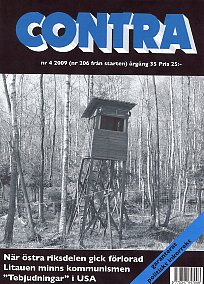
When Sweden lost Finland
by Tommy Hansson
This year the 200th anniversary of Sweden’s loss of Finland is remembered. For 600 years Finland was an integrated part of the joint kingdom of Sweden and Finland, usually called the eastern half of the realm. After the war with Russia 1808–1809 Sweden was forced to accept the biggest loss in any peace treaty – to cede Finland to the Russian Czar. The most decisive event in the war was the loss of the fortress Sveaborg (Suomenlinna) just outside Helsingfors (Helsinki) in May 1808. After more than 100 years under Russian control Finland achieved independence in 1918.
Lithuania remembers Communism
– and its victims
by C G Holm
Countries that were liberated from the Communist yoke at the turn of the 1980s into the 1990s have now, twenty years later, established museums and memorials commemorating the victims of communism and the liberation movement. Contra has previously reported on Terror House in Budapest (Hungary) and the Museum of Communism in Prague (Czechia). In this number we tell about the KGB Museum in the Lithuanian capital Vilnius, located in the former KGB headquarters where approximately 700 people were shot during the Communist years (the execution cell is preserved intact with bullet holes in the wall). All janitors and guides are former inmates of the KGB headquarters which included a major prison in the basement. We also tell about ”Stalin World” (Grutas Parkas) close to the town Druskininkai. Lithuanian canned mushroom millionaire Viliumas Malinauskas bought all major Communist statues in Lithuania, moved them to ”Stalin World” and also established an environment to show the new generation what communism really was about. The guard tower on the cover photo is from ”Stalin World”.
”Tea parties” – Americans protesting taxes
by Fredrik Runebert
During April Americans protested against high taxes, excessive government expenditure, spendthrift and bail-outs. Activities were organized at more than 300 places in all 50 states. The meetings were really a ”grass-root” movement. Columnist Glenn Harlan Reynolds at The Wall Street Journal means that you don’t need a large organization to organize large demonstrations, modern communication technology is enough.
Saddam did have weapons of mass destruction
by Tommy Hansson
General Georges Sada was one of Saddam Hussein’s most highly ranked generals and one of the most influential military advisors of his regime. He was also frank and a Presbyterian Christian. In his book Saddam’s Secrets general Sada gives an open pictuyre of the weapons of mass destruction that Saddam really possessed, on Saddams plöans for an attack on Israel and his plans to conquer the Arab world.
Converts from islam are threatened with capital punishment
by C G Holm
Muhammad met three other beliefs: Christianity, judaism and paganism. He immediately condemned paganism, but initially showed respect both for Christianity and Judaism. He called these two groups of belivers for the ”people of the book”. Contrary to the pagans they had holy scriptures that interpreted the contents of their belief. Muhammad himself absorbed important elements of Christianity and Judaism and thought that he himself developed and even fulfilled these religions. Thus he accepted Adam, Abraham, Moses and Jesus as prophets. But the last and greatest prophet was Muhammad himself. Muhammad accepted people with Christian and Jewish beliefs, but the never accepted that moslems converted to these religions. The only answer was capital punishment and that is still the sharia law, in principle still valid in many moslem courntries.
Patient movability in Europe
by Fredrik Runebert
The question where Swedish political parties had most difference in their views on politics in the June European Parliament election was the question of the rights of patients to get medical treatment abroad (at the expense of the public health insurance) if treatment is not available in the home country in a reasonable time.

